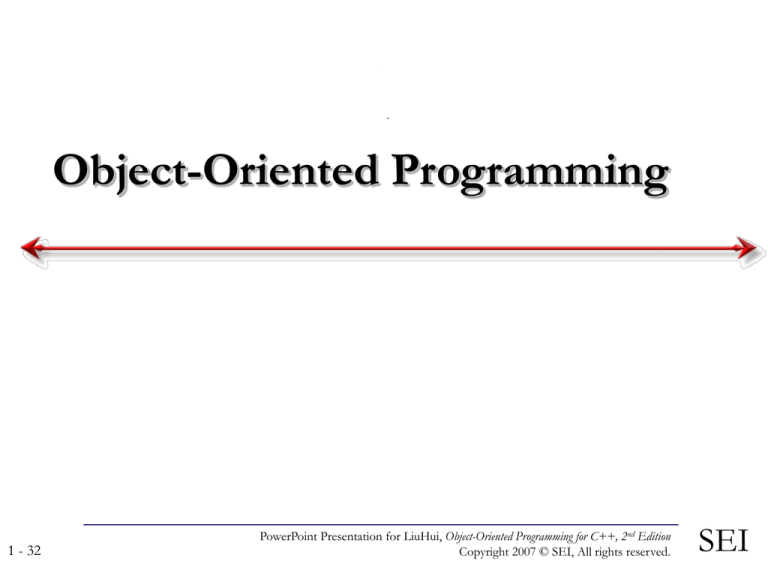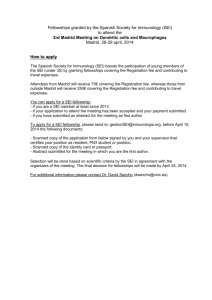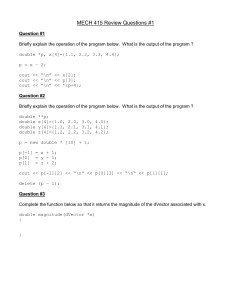
Object-Oriented Programming
1 - 32
PowerPoint Presentation for LiuHui, Object-Oriented Programming for C++, 2nd Edition
Copyright 2007 © SEI, All rights reserved.
SEI
Chapter2 From C to C++
2.1 Namespaces
2.2 Introduction to C++ Input/Output
2.3 Files
2.4 C++ Features
2.5 The Type string
2 - 32
PowerPoint Presentation for LiuHui, Object-Oriented Programming for C++, 2nd Edition
Copyright 2007 © SEI, All rights reserved.
SEI
2.1 Namespaces
名空间
3 - 32
PowerPoint Presentation for LiuHui, Object-Oriented Programming for C++, 2nd Edition
Copyright 2007 © SEI, All rights reserved.
SEI
Namespaces
C++ provides namespaces to prevent name conflicts.
namespace mfc {
int inflag;
// …
} // no closing semicolon required
namespace owl {
int inflag;
// …
} // no closing semicolon required
4 - 32
SEI
Namespaces – scope resolution operator
The scope resolution operator :: occurs between the
namespaces name and the variable.
mfc :: inflag = 3;
owl :: inflag = -823;
5 - 32
// mfc’s inflag
// owl’s inflag
SEI
Namespaces – using declaration
A using declaration(using声明) applies a single
item in the namespace.
namespace mfc {
int inflag;
void g(int);
//…
using mfc :: inflag;
inflag = 1;
mfc::g(6);
}
6 - 32
SEI
Namespaces – using directive
Using directive(using 指示)is equivalent to a using
declaration for each item in a namespace.
using namespace mfc;
inflag = 21;
g(-66);
owl::inflag = 341;
7 - 32
SEI
Namespaces - std
C++’s std namespaces includes all of the standard
libraries.
#include <iostream>
using namespace std;
int main() {
cout << "C++: one small step for the program, \n"
<< "one giant leap for the programmer\n";
return 0;
}
8 - 32
SEI
Conversion of C Header
The definitions, declarations, and so on in
nonstandard C++ “.h” headers typically are
not placed in namespaces.
The standard C header files have been
renamed: .h is dropped and a c is prefixed.
stdlib.h cstdlib
stdio.h cstdio
ctype.h cctype
…
9 - 32
SEI
2.2 Introduction to C++ Input/Output
C++ Input/Output – Manipulators(自己看)
10 - 32
PowerPoint Presentation for LiuHui, Object-Oriented Programming for C++, 2nd Edition
Copyright 2007 © SEI, All rights reserved.
SEI
C++ Input/Output
In C++, input/output is treated as a stream of
consecutive(连续的) bytes.
Thus C++ input/output is called stream input/output.
11 - 32
SEI
C++ Input/Output
The header iostream must be included to use C++
standard input/output.
cin: the standard input
cout: the standard output (buffered)
cerr: the standard error (not buffered)
Two Operators, both operators recognize the data
type supplied, so no format string (like that required
for printf/scanf) is necessary.
>>: used for input
<<: used for output
12 - 32
SEI
C++ Input/Output
operator >> and << recognize the data type supplied,
so no format string is necessary.
The default action of the input operator >> is to skip
white space before reading the next input item, even
if the variable is of type char.
13 - 32
SEI
C++ Input/Output
#include <iostream>
using namespace std;
int main() {
int val, sum = 0;
if a value is read into
cout << "Enter next number: "; val, cin >> val is
while( cin >> val ) {
true; otherwise, false.
sum += val;
cout << "Enter next number: ";
}
cout << "Sum of all values: " << sum << '\n';
return 0;
}
14 - 32
SEI
2.3 Files
15 - 32
PowerPoint Presentation for LiuHui, Object-Oriented Programming for C++, 2nd Edition
Copyright 2007 © SEI, All rights reserved.
SEI
Files
The header file fstream must be included to use files.
ifstream: to read from a file
ofstream: to write to a file
>>: used to file read
<<: used to file write
16 - 32
SEI
#include <fstream>
using namespace std;
const int cutoff = 6000;
const float rate1 = 0.3;
const float rate2 = 0.6;
int main() {
ifstream infile;
ofstream outfile;
int income, tax;
infile.open( "income.in" );
outfile.open( "tax.out" );
while ( infile >> income ) {
if ( income < cutoff )
tax = rate1 * income;
else
tax = rate2 * income;
outfile << "Income = " << income << " greenbacks\n"
<< "Tax = " << tax << " greenbacks\n";
}
infile.close();
outfile.close();
return 0;
}
Files
17 - 32
SEI
Files – Testing Whether Files Are Open
After opening a file, it is a good idea to check whether
the file was successfully opened.
18 - 32
SEI
#include <fstream>
#include <iostream>
using namespace std;
const int cutoff = 6000;
const float rate1 = 0.3;
const float rate2 = 0.6;
int main() {
ifstream infile;
ofstream outfile;
int income, tax;
infile.open( "income.in" );
if (!infile) {
cerr << " Unable to open incom.in!\n ";
exit(0);
}
outfile.open("tax.out" );
if (!outfile) {
cerr << " Unable to open tax.out!\n ";
exit(0);
}
//…
infile.close();
outfile.close();
return 0;
}
Files - Testing Whether Files Are Open
19 - 32
SEI
2.4 C++ Features
Casts(类型转换,不用看)
Constants(自己看)
The Data Type bool
Enumerated Types (自己看)
Defining variables (自己看)
Structures
20 - 32
PowerPoint Presentation for LiuHui, Object-Oriented Programming for C++, 2nd Edition
Copyright 2007 © SEI, All rights reserved.
SEI
C++ Features – The Data Type bool
In C, true is represented by nonzero, and false by zero.
C++ added the integer type bool to represent the
boolean values true and false.
21 - 32
SEI
C++ Features – Structures
C++ has modified C’s version of structures.
In addition to data members, in C++ a struct can
contain functions.
在C++中,结构被看成是一种特殊的类。(以后详细介
绍)
22 - 32
SEI
2.5 The Type string
23 - 32
PowerPoint Presentation for LiuHui, Object-Oriented Programming for C++, 2nd Edition
Copyright 2007 © SEI, All rights reserved.
SEI
The Type string
C++ furnishes the type string as an alternative to C’s
null-terminated arrays of char.
By using string, the programmer does not have to be
concerned about storage allocation or about handling
the annoying null terminator.
24 - 32
SEI
The Type string
功能
举例
String中的方法
String Length
length()
string s1; int size = s1.length();
Output Strings
cout<<
string s1 = "abcd"; cout << s1 ;
Input Strings
cin>>
string s1;
Assignment
=
string s1, s2;
Concatenation
+
string s1 = "abcd", s2 = "efg";
string s3 = s1 + s2;
Modify String
erase、insert、
replace、swap
Extract
substring
substr
Searching
find
Comparing
==、!=、<、<=、
>、>=
25 - 32
cin >> s1;
s1 = "abcd"; s2 = s1;
string s1 = "abcdergrehj";
string s2 = s1.substr(4,6);
SEI
The Type string - erase
The function erase removes a substring from a string.
#include <iostream>
#include <string>
using namespace std;
int main() {
string s = "Ray_Dennis+Steckler";
s.erase(4, 7);
// 从第4个字符开始连续删除7个字符 (Ray_Steckler)
cout << s << '\n';
s.erase(4);
// 删除从第4个字符开始的所有字符 (Ray_)
cout << s << '\n';
return 0;
}
26 - 32
SEI
The Type string - insert
The function insert inserts a string at specified position.
#include <iostream>
#include <string>
using namespace std;
int main() {
string s1 = "Ray Steckler";
string s2 = "Dennis ";
s1.insert(4, s2); // 将字符串s2插入到字符串s1的第4个字符之后
cout << s1 << '\n';
cout << s2 << '\n';
return 0;
}
27 - 32
SEI
The Type string - replace
The function replace replaces a substring with a
specified string.
28 - 32
SEI
The Type string - replace
#include <iostream>
#include <string>
using namespace std;
int main() {
string s1 = "Ray Dennis Steckler";
string s2 = "Fran";
s1.replace(4, 6, s2); // 用字符串s2替换字符串s1中从第4个字符
// 开始的连续6个字符
cout << s1 << '\n';
cout << s2 << '\n';
return 0;
}
29 - 32
SEI
The Type string - swap
#include <iostream>
#include <string>
using namespace std;
int main() {
string s1 = "Ray Dennis Steckler";
string s2 = "Fran";
s1.swap(s2);
// 将字符串s1和字符串s2的值互换
cout << s1 << '\n';
cout << s2 << '\n';
return 0;
}
30 - 32
SEI
The Type string - find
The function find is used to search a string for a substring.
#include <iostream>
#include <string>
using namespace std;
int main() {
string s1 = "Ray Dennis Steckler";
string s2 = "Dennis";
int f = s1.find(s2);
// 字符串s1中是否出现了字符串s2
if ( f < s1.length() )
cout << "Found at index: " << f << '\n';
else cout << "Not found\n";
return 0;
}
31 - 32
SEI






